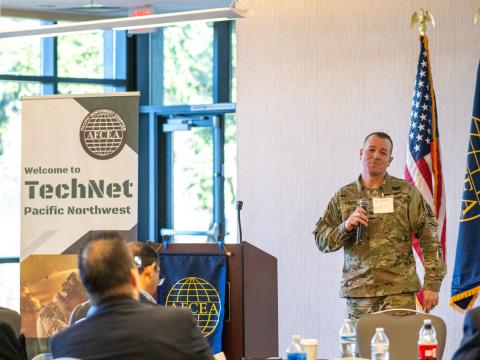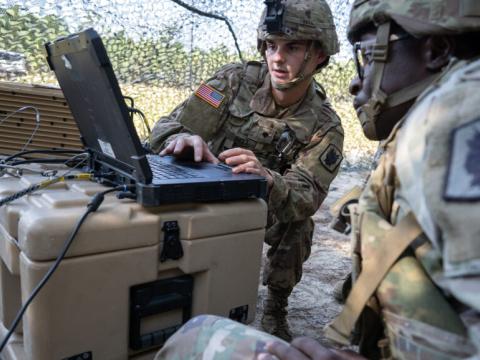Joint Tactical Radio System Underway
Initial contract covers units for ground vehicles, helicopters.
The U.S. military’s goal of a network-centric warfare capability is a step closer to reality with the recent contract award for the development of a long-awaited family of advanced radios. The devices will eliminate communications difficulties between terrestrial and airborne units through the use of common waveforms, creating greater situational awareness and enhanced survivability for warfighters.
Low interoperability among legacy radio systems has challenged the U.S. Defense Department for decades. Experiences in the Gulf War highlighted the need for fully interoperable, seamless communications to shape operations and win decisively. Technological advances such as battlefield wireless networking have created additional needs as commanders began to require live data and video feeds on top of input from traditional voice systems.
The Joint Tactical Radio System (JTRS) program was initiated to develop a device that could connect legacy communications bands and create new waveforms to meet future service needs. A family of software reprogrammable radios built around an open software architecture, JTRS is designed to provide reliable multichannel voice, data, imagery and video communications. The software-based nature of the system permits users the flexibility to select optimal waveforms to meet mission demands.
The radio’s core modules can be configured for ground, nautical and airborne platforms. Digital signal processing provides flexibility and operational simplicity through end-to-end communications connectivity, packet formatting and packet switch protocols. By using spread spectrum modulation, the system also supports low-probability-of-intercept and antijam capabilities, transmit power controls and embedded encryption. JTRS provides radio coverage in a frequency range from 2 megahertz to 2 gigahertz. Additional capabilities include local area network services for both line-of-sight and beyond-line-of-sight data and voice links and the use of adaptive routing techniques to enhance network survivability.
The first part of this multicontract program was awarded to an industry team led by The Boeing Company, Seal Beach, California. Boeing’s team consists of TRW Tactical Systems Division, Carson, California; Rockwell Collins Government Systems, Cedar Rapids, Iowa; BAE Systems Communications, Navigation and Identification, Wayne, New Jersey; and Harris Corporation Radio Frequency (RF) Communications Division, Rochester, New York.
Known as Cluster 1, the first JTRS award will supply the U.S. Army, U.S. Air Force Tactical Air Control Party and U.S. Marine Corps ground radios as well as Army rotary wing aircraft radios. Valued at approximately $475 million, Cluster 1 encompasses a 44-month system development and demonstration phase. Boeing officials anticipate early operational assessment testing to take place in the summer of 2004 with low-rate initial production to begin in 2005. If this phase is fully executed, the baseline contract and options may exceed $2 billion. Approximately 10,000 vehicular and airborne systems will be manufactured in the low-rate initial phase of Cluster 1, with future orders expected to exceed 100,000 units, company officials say.
As prime contractor, Boeing is responsible for the overall systems architecture and design, systems engineering, communications integration and program management. TRW will support Boeing with systems engineering and wideband network management efforts and is responsible for integrating ground platforms. Rockwell Collins and BAE Systems, with support from Harris Corporation, will develop and produce Army and Marine Corps ground vehicular and airborne systems and the Tactical Air Control Party communications system for the Air Force.
This initial phase of the program is especially important to ground forces because it will lead to the application of software definable technology across a spectrum of activities, Lt. Gen. Carl O’Berry, USAF (Ret.), Boeing’s vice president of strategic architecture, Anaheim, California, explains. The firm is approaching this new technology from a systems-based perspective. “We’ve created this huge legacy of capabilities that need to be integrated almost on demand, whether they are large or small systems. The objective for Boeing is to enable that global integrated battlespace,” he said.
Gen. O’Berry notes that JTRS is the first substantiation of a tactical capability that will permit airborne and ground-based platforms to communicate easily. Citing the example of the integrated circuit, the general explained that the system creates a common underlying architecture so equipment can automatically interoperate. Users will select frequencies to meet their operational goals without thinking about interoperability in the same way engineers now select different types of microprocessor chips to use on a circuit board.
The contract also moves the U.S. military a step closer to its goals for network-centric warfare, maintains Col. Steven A. MacLaird, USAF, joint systems program director and program manager, Joint Tactical Radio System Joint Program Office, Arlington, Virginia. But understanding how to fully use this new interconnectivity is the next challenge.
“Now that I can talk to everybody, one of the issues is that maybe I don’t want to listen to everyone. If I’m landing an airplane right now, I don’t care what’s going on 30 miles away. All I want to know is that I can land safely,” he says.
Determining efficient uses for networked information could transform combined operations, but exact operational procedures must be worked out. The colonel compares JTRS and the military’s growing understanding of network-centric warfare capabilities to the development of computers in the 1970s. At that time, the goal was to use technology to create a paperless office; the potential of applications such as the Internet or e-mail was unknown.
The flexibility of JTRS also will help with spectrum allocation issues. The U.S. military cannot operate some of its systems within their designated bandwidth ranges in many parts of the world, Col. MacLaird explains. JTRS will permit a radio network manager to select and move certain waveforms into different frequency ranges. For example, if a system normally operates at 800 gigahertz, it could be moved to a 400-gigahertz band. “Because every waveform has its own pattern, all we’re doing is picking up that signature and moving it into another band,” he says.
In its initial deployment, JTRS will support 24 waveforms, 23 of which are legacy systems such as the single channel ground and airborne radio system and enhanced position location reporting system. The 24th is the JTRS-unique wideband networking waveform (WNW) designed to transmit voice, video and data signals. It will ultimately replace a number of existing waveforms that will slowly be phased out, Allen B. Ashby, vice president and general manager of Boeing’s Battle Management/Command, Control and Communications (BMC3) and Strategic Systems, Anaheim, California, observes. However, he predicts that JTRS-specific waveforms will not become predominant until sometime around 2010 to 2015.
Ashby believes that the system’s open architecture and the software waveform were key items that helped Boeing win the contract. He notes that one of the radio’s features that differed from its competitors’ is the capability for soldiers to change channel levels in the field. Because individual frequencies can be changed over the air or by plugging in a new module, the entire unit can remain in operation.
A networking function serves to link all of the legacy waveforms in the radio, permitting interoperability among systems. However, the WNW applies a modern, Internet-type paradigm to the battlefield, Alejandro M. Lopez, Boeing’s director of network communication systems, integrated government systems at BMC3 and Strategic Systems, explains. The WNW provides a wireless Internet-type environment to supplant 20- to 30-year-old legacy waveforms.
The new waveform also is important because JTRS radios can transmit data in excess of 5 megabits per second—far faster than any legacy systems, Lopez says. The WNW has an Internet protocol (IP) backbone, permitting transmission of IP packets. It also operates in several different modes such as antijamming, low probability of detection and intercept, and a mode for bandwidth efficiency that permits large amounts of data to move in low-bandwidth environments. A big-pipe, high-data-rate mode also is part of the waveform.
Lopez maintains that the JTRS program is not about hardware, but networking. This capability is derived from waveforms like the WNW, which sets the template for future JTRS-specific transmissions. “It’s the one that we hope will break the cycle of interoperability problems in legacy waveforms. This is the waveform that we hope will network everything later on, whether it is rotary wing aircraft or platforms for the other services,” he says.
As JTRS systems are deployed across the military, they will replace legacy units, but not on a one-for-one basis. Col. MacLaird notes that some 750,000 radios are in use across the Defense Department. Many platforms, such as high mobility multipurpose wheeled vehicles, use up to five radios to meet all of their communications needs. Because of its multifunctional nature, a single JTRS unit will replace multiple radios on an individual platform.
The modular nature of the system also permits easy upgrades. The colonel notes that the government currently spends billions of dollars buying new software upgrades for all of its systems. However, it has exclusive rights to upgrade JTRS software, greatly reducing these costs, he says.
Manufacturers also will benefit from the open architecture of the JTRS. Because the various components of the radio use the same software, the hardware suppliers’ business changes, says Jeffrey Markel, president of BAE Systems Communications, Navigation and Identification. He likens this open architecture to the personal computer industry where customers can buy many different brands of machines that all run the same programs.
The modular nature of the radios permits easy definition between various modules and components while permitting them to function within the system’s overall architecture, Markel explains. As new technologies or applications are developed, they can be dealt with on a module-by-module basis instead of affecting the entire device, he says.
Although software is a key component of the JTRS, many radios and modules will be produced as the program evolves. “There’s going to be a lot of hardware procured for this,” Chester A. Massari, president of Harris Corporation’s RF Communications Division, observes. “Also, in the foreseeable future, elements of the radio system are going to be physical such as programming cards and receiving systems. The big thing is that the system’s capabilities—the software and waveforms—can be plugged into different radios, but there’s still going to be hardware associated with it,” he says.
Additional information on the Joint Tactical Radio System is available on the World Wide Web at http://www.boeing.com, http://www.trw.com, http://www.rockwellcollins.com, http://www.baesystems.com and http://www.harris.com.




Comments